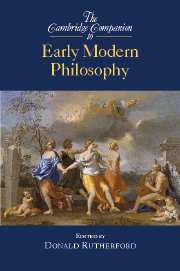Book contents
- Frontmatter
- Introduction
- 1 Innovation and orthodoxy in early modern philosophy
- 2 Knowledge, evidence, and method
- 3 From natural philosophy to natural science
- 4 Metaphysics
- 5 The science of mind
- 6 Language and logic
- 7 The passions and the good life
- 8 The foundations of morality: virtue, law, and obligation
- 9 Theories of the state
- 10 Theology and the God of the philosophers
- 11 Scholastic schools and early modern philosophy
- 12 Toward enlightenment: Kant and the sources of darkness
- Short biographies of major early modern philosophers
- Bibliography
- Index
- Series list
3 - From natural philosophy to natural science
Published online by Cambridge University Press: 28 January 2007
- Frontmatter
- Introduction
- 1 Innovation and orthodoxy in early modern philosophy
- 2 Knowledge, evidence, and method
- 3 From natural philosophy to natural science
- 4 Metaphysics
- 5 The science of mind
- 6 Language and logic
- 7 The passions and the good life
- 8 The foundations of morality: virtue, law, and obligation
- 9 Theories of the state
- 10 Theology and the God of the philosophers
- 11 Scholastic schools and early modern philosophy
- 12 Toward enlightenment: Kant and the sources of darkness
- Short biographies of major early modern philosophers
- Bibliography
- Index
- Series list
Summary
In 1619, after one of his first encounters with Descartes, Isaac Beeckman, pleased to find a kindred spirit, noted that “physico-mathematici” are “paucissimi” - very few. Aside from himself, Descartes, and perhaps Galileo, Beeckman knew of no others. A half-century later, Leibniz noted that “recent philosophers all wish to explain physical matters mechanistically (mechanice).” The period between witnessed a transformation in the concepts, methods, and institutions of natural philosophy, so remarkable that it is tempting simply to grant that Bacon’s promised “new instauration” - in later language, a revolution - was accomplished, and the philosophy of the schools wholly superseded.
That transformation was uneven and incomplete. Even in physics, though there was undoubtedly profound change in fundamental concepts, explanations of particular phenomena were sometimes almost rote “mechanizations” of explanations already found in scholastic works. At the outset, many of the phenomena themselves were not new. Even more so does this hold in chemistry and physiology. Descartes’s Treatise on Man, written in the early 1630s, though it “mechanizes” physiology, does so almost entirely on the basis of the anatomy and physiology of his nonmechanist predecessors. The program of the Treatise could have proceeded perfectly well without Harvey’s discovery of the circulation of the blood and Kepler’s new theory of vision. Adherents of Aristotelianism, moreover, were not without resources to accommodate some, if not all, of the novelties of their rivals. Honoré Fabri rejected both Cartesianism and Gassendism.
- Type
- Chapter
- Information
- The Cambridge Companion to Early Modern Philosophy , pp. 67 - 94Publisher: Cambridge University PressPrint publication year: 2006
- 1
- Cited by



